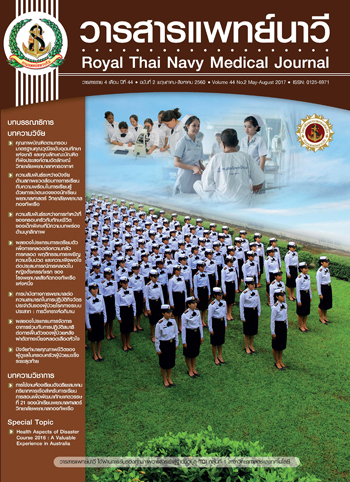Relationship between Learning Environment Factors and Self-Directed Learning Readiness of Nursing Students at Royal Thai Navy College of Nursing
Main Article Content
Abstract
This research aimed to study the readiness for self-directed learning of the nursing
students at Royal Thai Navy College of Nursing, and to study the learning environment
factors which were the facilitator role of the instructors, the relationship with peers and the
physical condition of the surroundings. It also studied about the relationship between the
learning environment factors and the readiness for self-directed learning. The subjects were
stratified randomly selected to include 154 nursing students from first year to fourth year in
academic year 2016 at Royal Thai Navy College of Nursing. The research tools composed of
a questionnaire about the facilitator role of the instructors, a questionnaire about relationship
with peers, a questionnaire about the physical condition of the surroundings, and a readiness
assessment form on self-directed learning. The reliability of the four tools were .95, .79,
.74, and .91 respectively. The data were analyzed using frequency, percentage, average,
standard deviation, and Pearson correlation coefficient.
The results were shown as following:
1. The readiness for self-directed learning of the nursing students was at a high
level (Mean = 3.71, SD = .39) with the highest average in ability to conduct self-assessment
(Mean = 4.20, SD = .54) and the lowest average in characteristics promoting self-directed
learning which was at the moderate level. (Mean = 3.49, SD = .49)
2. The nursing students reported that the instructors performed the role of facilitator
at a high level (Mean = 3.71 – 3.84, SD = .40 - .68). The relationship with peers was also
rated at a high level (Mean = 4.14, SD = .47) whereas the suitable physical condition of the
surrounding is generally rated at the moderate level. (Mean = 3.25, SD = .56)
3. The moderate positive correlation was found between the readiness for self-directed
learning of the nursing students and the learning environment factors, including the facilitator
role of the instructors, the relationship with peers and the physical condition of the
surroundings at Royal Thai Navy College of Nursing with the significance level at .01 (r =
.595, .387 and .386 respectively). The highest correlation was the relationship between the
role of the instructors in setting the goals and analyzing the learners’ needs and the readiness
for self-directed learning. (r = .494)
Article Details

This work is licensed under a Creative Commons Attribution-NonCommercial-NoDerivatives 4.0 International License.
References
เลขาธิการสภาการศึกษา, สำนักงาน. ข้อเสนอการปฏิรูปการศึกษาในทศวรรษที่สอง (พ.ศ. 2552-2561). พิมพ์ครั้งที่ 3. กรุงเทพมหานคร: พริกหวานกราฟฟิค; 2552.
วิจารณ์ พานิช. วิถีสร้างการเรียนรู้เพื่อศิษย์. พิมพ์ครั้งที่ 3. กรุงเทพมหานคร: ตถาตา พับลิเคชั่น; 2555.
Knowles MS. Self-directed learning: A guide for learners and teachers. New York: Association Press; 1975.
สุรีรัตน์ ศรีบุญเรือง. การศึกษาปัจจัยบางประการที่สัมพันธ์กับความพร้อมในการเรียนรู้ด้วยการนำตนเองของนักศึกษาชั้นปีที่ 2 ในกลุ่มศูนย์สุขศาสตร์ มหาวิทยาลัยธรรมศาสตร์. [ปริญญานิพนธ์การศึกษามหาบัณฑิต สาขาการวิจัยและสถิติทางการศึกษา]. มหาวิทยาลัยศรีนครินทรวิโรฒ; 2550.
ปวิชญา ผาสุข, สุวพร เซ็มเฮง, ละเอียด รักษ์เผ่า. การศึกษาปัจจัยบางประการที่ส่งผลต่อความพร้อมในการเรียนรู้ด้วยตนเองของนักศึกษาภาคปกติมหาวิทยาลัยราชภัฏสวนดุสิต. วารสารการวัดผลการศึกษา 2555;17(2):143-60.
พิศดี มินศิริ. ปัจจัยบางประการที่ส่งผลต่อความพร้อมในการเรียนรู้ด้วยการนำตนเองของนักศึกษาพยาบาลศาสตรบัณฑิต ชั้นปีที่ 1 วิทยาลัยพยาบาลเครือข่ายภาคกลาง ในสังกัดสถาบันพระบรมราชชนก กระทรวงสาธารณสุข. [ปริญญานิพนธ์การศึกษามหาบัณฑิต สาขาการวิจัยและสถิติทางการศึกษา]. มหาวิทยาลัยศรีนครินทรวิโรฒ; 2547.
กนกวรรณ ทองฉวี. ความสัมพันธ์ระหว่างความรู้สึกมีคุณค่าในตนเอง บทบาทอาจารย์ในการอำนวยความสะดวกในการเรียนรู้ สภาพแวดล้อมในสถาบันกับความพร้อมในการเรียนรู้ด้วยตนเองของนักศึกษาพยาบาล สถาบันการศึกษาพยาบาลของรัฐ สังกัดทบวงมหาวิทยาลัย. [วิทยานิพนธ์พยาบาลศาสตรมหาบัณฑิต สาขาการพยาบาลศึกษา]. จุฬาลงกรณ์มหาวิทยาลัย; 2545.
ปรินดา ตาสี. ลักษณะทางจิตและสภาพแวดล้อมทางการเรียนที่เกี่ยวข้องกับความพร้อมในการเรียนรู้ด้วยการนำตนเองของนักศึกษาชั้นปีที่ 1 ของมหาวิทยาลัยในกรุงเทพมหานคร. [ปริญญานิพนธ์วิทยาศาสตร์มหาบัณฑิต สาขาการวิจัยพฤติกรรมศาสตร์ประยุกต์]. มหาวิทยาลัยศรีนครินทรวิโรฒ; 2551.
อมรรัตน์ เสตสุวรรณ, อรชร ศรีไทรล้วน. ความสัมพันธ์ระหว่างสภาพแวดล้อมในคณะพยาบาลศาสตร์กับความพร้อม ในการเรียนรู้ด้วยตนเองของนักศึกษาพยาบาล คณะพยาบาลศาสตร์เกื้อการุณย์ มหาวิทยาลัยนวมินทราธิราช. วารสารเกื้อการุณย์ 2557;21(ฉบับพิเศษ):124-38.
สุมลรัตน์ สมคะเน. ความสัมพันธ์ระหว่างสภาพแวดล้อมที่เอื้อต่อการเรียนรู้ด้วยตนเองกับความพร้อมในการเรียนรู้ด้วยตนเองของนักศึกษามหาวิทยาลัยรามคำแหง. [วิทยานิพนธ์ศึกษาศาสตรมหาบัณฑิต สาขาพัฒนาทรัพยากรมนุษย์]. มหาวิทยาลัยรามคำแหง; 2553.
คณะกรรมการการศึกษาแห่งชาติ, สำนักงาน. พระราชบัญญัติการศึกษาแห่งชาติ พ.ศ. 2542 และที่แก้ไขเพิ่มเติม (ฉบับที่ 2) พ.ศ. 2545. กรุงเทพมหานคร: พริกหวานกราฟฟิค; 2546.
มณี อาภานันทิกุล, รุจิเรศ ธนูรักษ์, ยุวดี ฦาชา. การพัฒนาเครื่องมือความพร้อมในการเรียนรู้ด้วยตนเองของนักศึกษาพยาบาลไทยระดับปริญญาตรี. วารสารสภาการพยาบาล 2551;23(2):52-69.
Guglielmino LM. Development of self-directed learning readiness scale. Dissertation Abstract International 1977;(38):64-64A.
Fisher M, King J, Tague G. Development of Self-directed learning readiness scale for nursing education. Nurse Educ Today 2001;21(7):516-25.
ศิริชัย กาญจนวาสี. สถิติประยุกต์สำหรับการวิจัย. พิมพ์ครั้งที่ 6. กรุงเทพมหานคร: โรงพิมพ์แห่งจุฬาลงกรณ์มหาวิทยาลัย; 2555. หน้า 148.
บุญใจ ศรีสถิตย์นรากูร. การพัฒนาและตรวจสอบคุณภาพเครื่องมือวิจัย: คุณสมบัติการวัดเชิงจิตวิทยา. กรุงเทพมหานคร: โรงพิมพ์แห่งจุฬาลงกรณ์มหาวิทยาลัย; 2555. หน้า 95.
วัลภา ศรีบุญพิมพ์สวย. ปัจจัยที่มีอิทธิพลต่อการเรียนรู้ด้วยการนำตนเองของนักศึกษาพยาบาลศาสตร์ วิทยาลัยพยาบาลบรมราชชนนี อุดรธานี. วารสารการพยาบาลและการศึกษา 2557;7(4):78-91.
Klunklin A, Viseskul N, Sripusanapan A, Turale S. Readiness for self-directed learning among nursing students in Thailand. Nurs Health Sci 2010;12(2):177-81.

